DOI: https://doi.org/10.1038/s41467-024-45092-7
PMID: https://pubmed.ncbi.nlm.nih.gov/38296942
تاريخ النشر: 2024-01-31
مولدات الطاقة المرنة بواسطة أفلام رقيقة من Ag2Se بأداء حراري كهربائي قياسي مرتفع
تم القبول: 15 يناير 2024
نُشر على الإنترنت: 31 يناير 2024
(أ) التحقق من التحديثات
الملخص
استكشاف مواد الكهروحرارية الجديدة القريبة من درجة حرارة الغرفة أمر مهم لاستبدال المواد الحالية ذات التكلفة العالية
تكنولوجيا مدعومة
تعزيز الأداء الكهروحراري. ومع ذلك، لا يمكن إنكار أن تحسين
النتائج والمناقشة
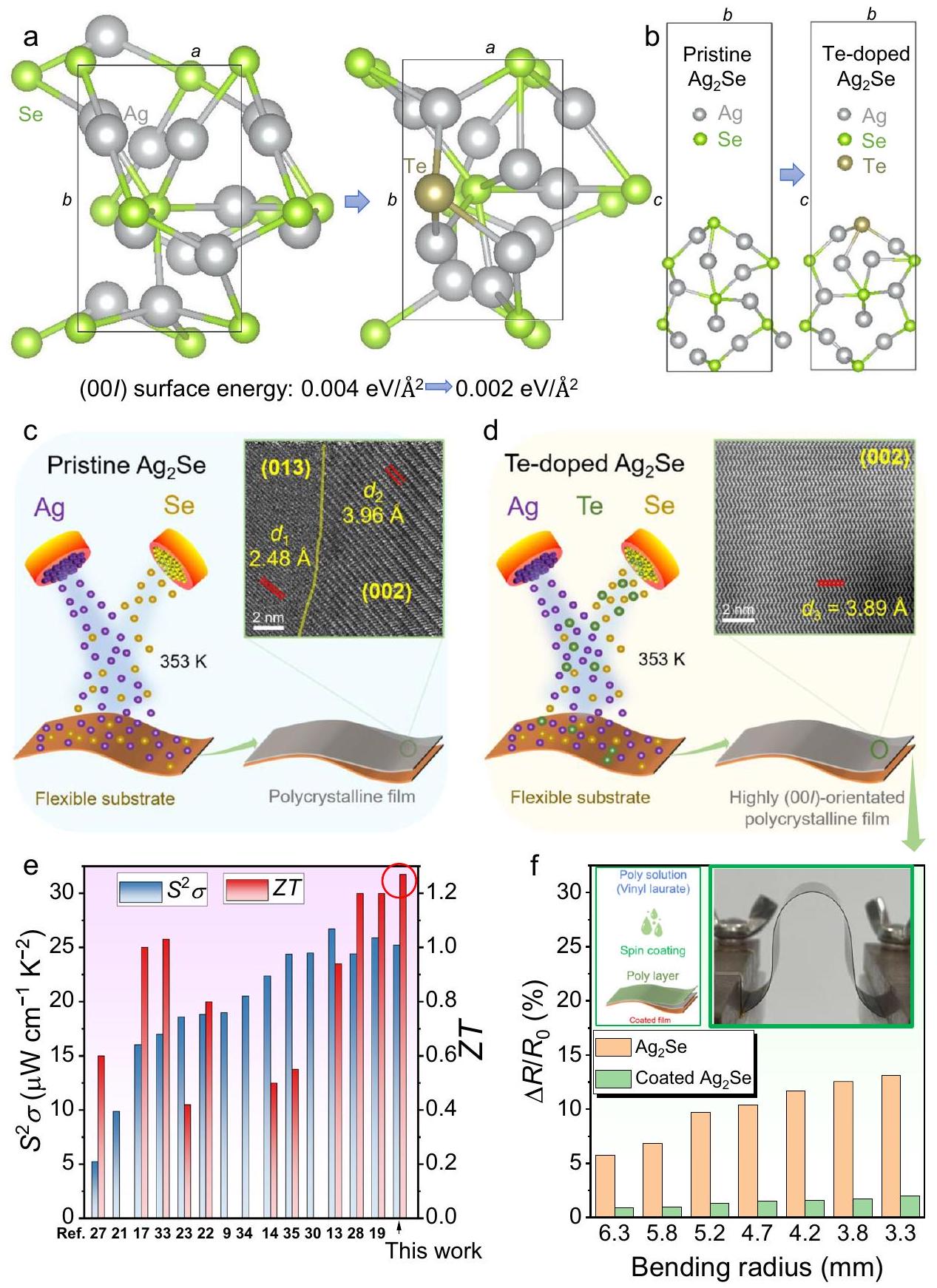
ويمكن أن يتبخر التيلوريوم من السطح خلال عملية المعالجة الحرارية. وبالتالي، تختلف التركيب الفعلي النهائي قليلاً عن التركيب الاسمي. لحسن الحظ، زادت محتويات التيلوريوم الفعلية في الأفلام أيضًا مع زيادة التركيب الاسمي لمحتويات التيلوريوم. وهذا يشير إلى أن التلويث بالتيلوريوم يمكن أن يكون ناجحًا.
تم تحقيق ذلك، ولم يتم ملاحظة أي حد للتعاطي حتى الآن. وهذا يشير إلى أنه تحت ظروف تعاطي Te بتركيز منخفض، فإن تعاطي Te له معدل نجاح مرتفع. لتحليل تأثير تعاطي Te على الأداء الحراري الكهربائي للأفلام بشكل أفضل، استخدمنا التركيز الذري الفعلي لـ Te كمتغير، يُشار إليه بـ
| التكوين الاسمي | فضة (نسبة مئوية بالوزن) | Se (نسبة مئوية بالوزن) | Te (نسبة مئوية بالوزن) |
|
|
66.8 | ٣٣.٢ | 0 |
|
|
66.4 | ٣٢.٩ | 0.7 |
|
|
66.0 | ٣٢.٧ | 1.3 |
|
|
65.6 | ٣٢.٥ | 1.9 |
|
|
65.2 | ٣٢.٢ | 2.6 |
|
|
٦٤.٧ | ٣٢.١ | 3.2 |
|
|
٦٤.٣ | 31.9 | 3.8 |
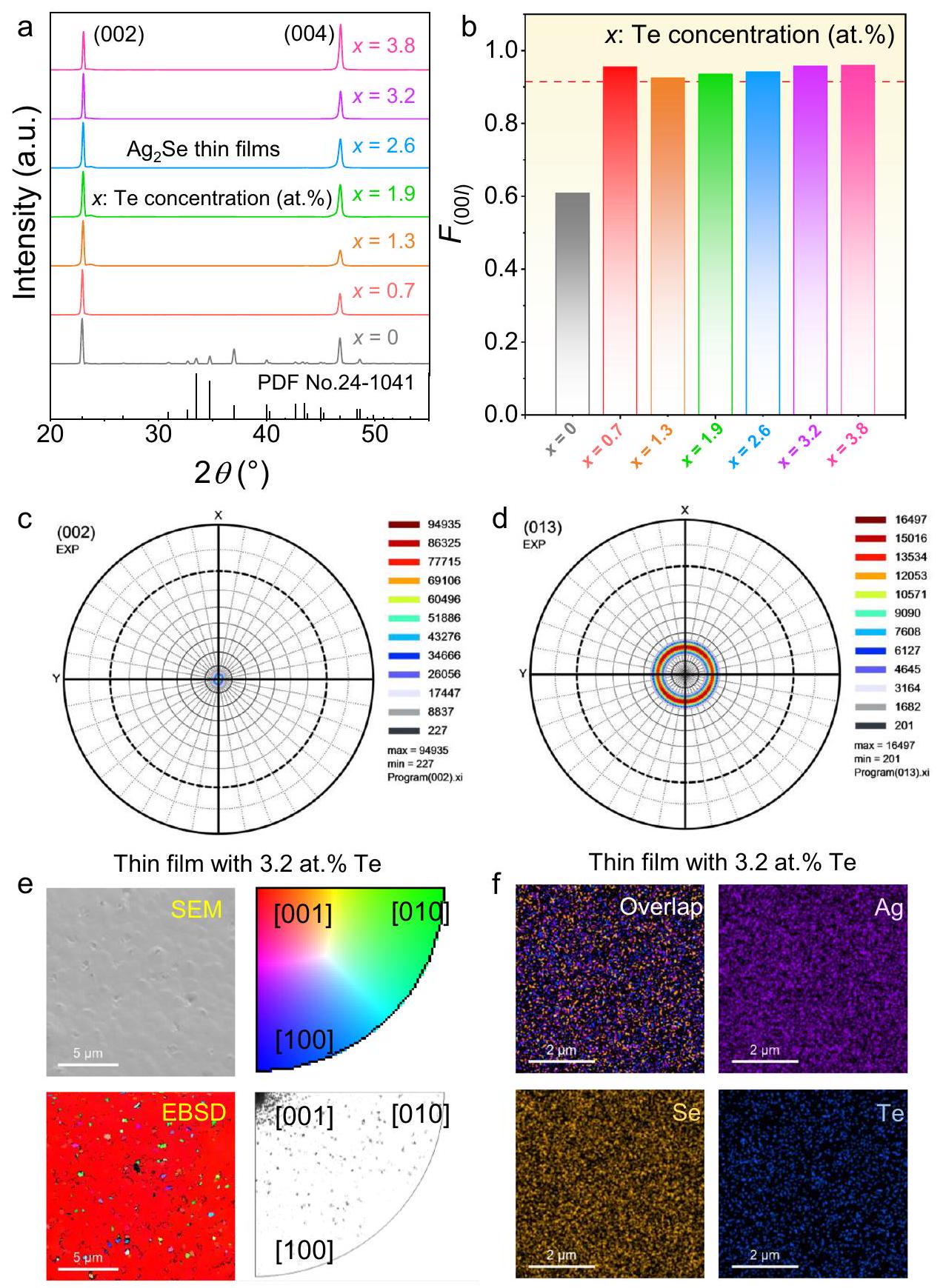
يظهر التلاعب ميزة موجهة بشكل نموذجي مع حبيبات متساوية الاتجاه حيث تم ملاحظة قمم (00l) فقط (قمم (002) و(004)). الشكل 2ب يقارن عوامل التوجه المحددة.
يظهر الفرق في التباين. السهم يشير إلى نقطة عيب محتملة من
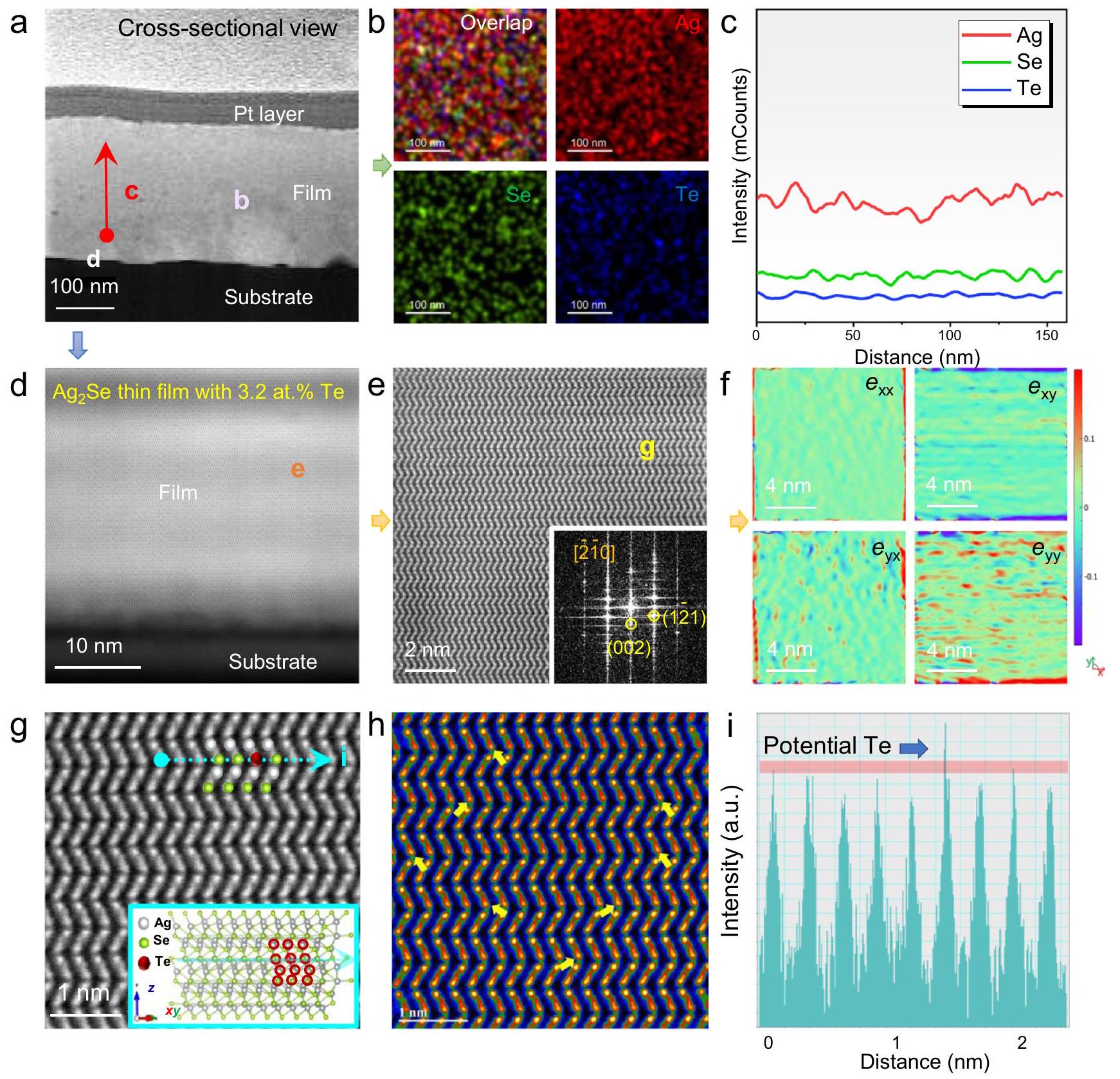
نمط تحويل فورييه السريع (FFT) مع معلومات مفهرسة.
تم تحسينه تدريجياً من خلال زيادة تركيز الشوائب من عنصر التيلوريوم لتحقيق الذروة
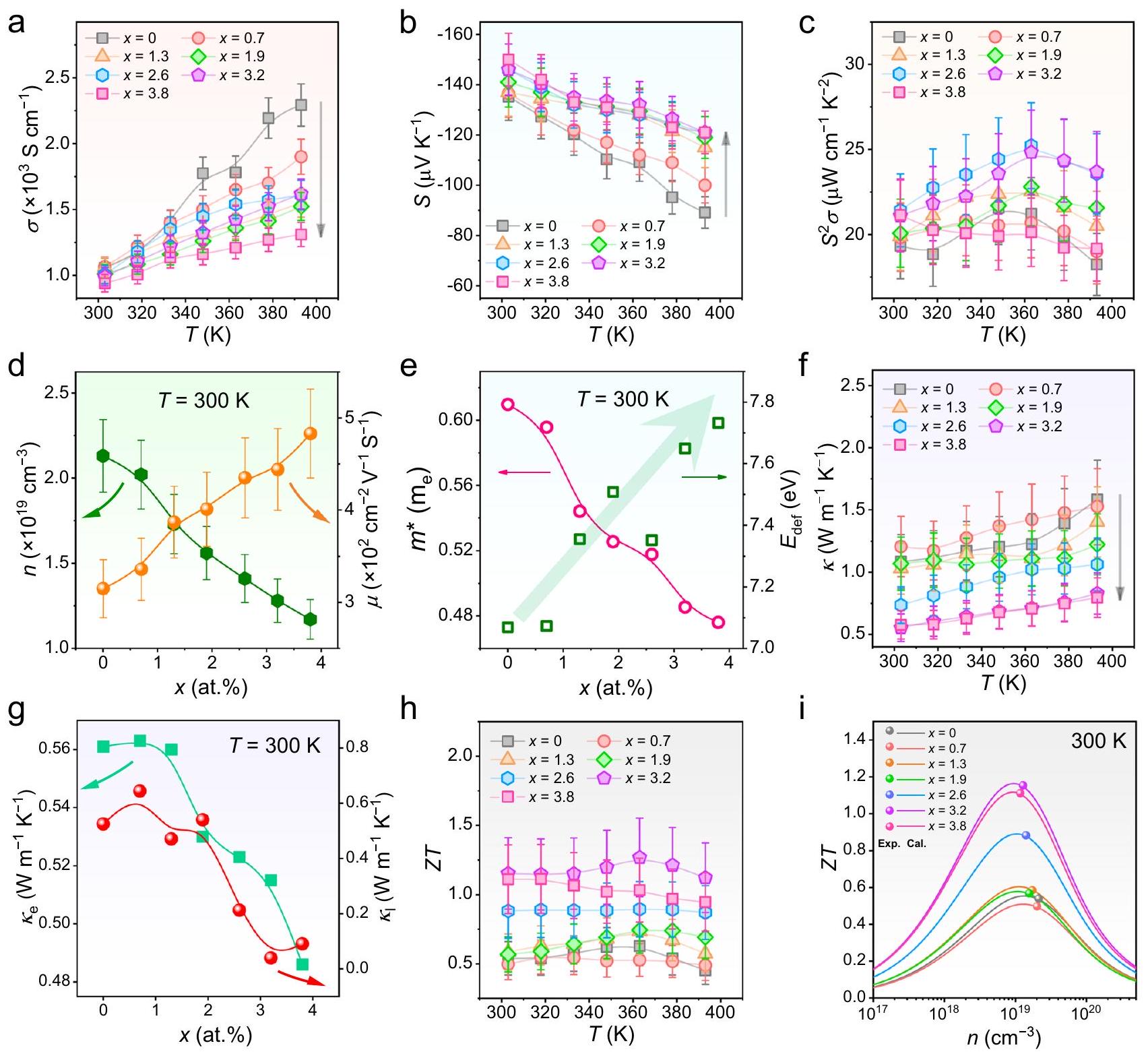
تم الحصول على فيلم رقيق عالي الأداء، ولكن هناك حاجة إلى تحسينات كبيرة في مرونته. في هذا العمل، قمنا بتصميم طبقة واقية مصنوعة من مركبات البوليمر العضوي
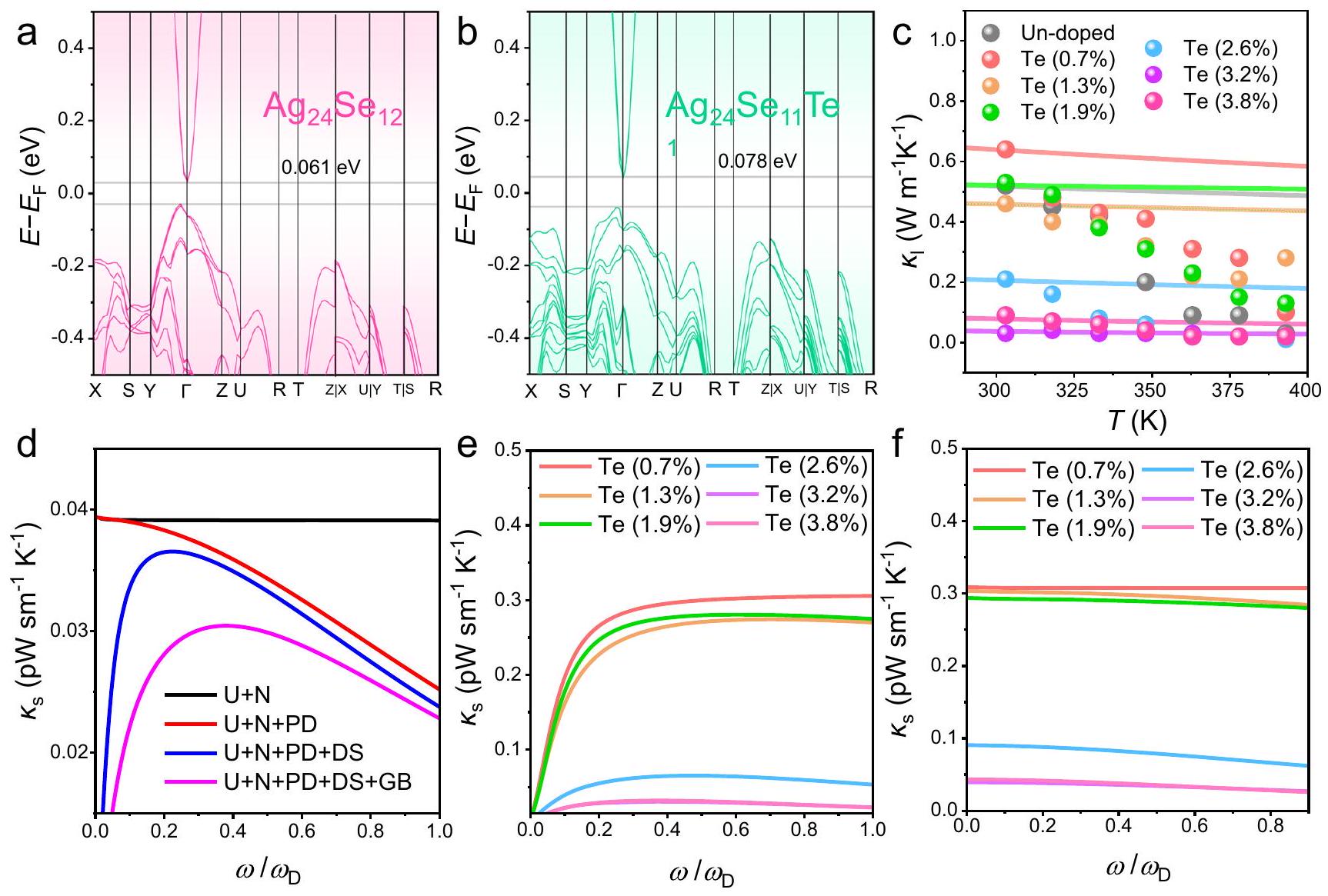
مقاس
تُقدم النتائج في الجدول التكميلي 3. الشكل 6f يقارن الجهد المقاس عند ارتداء F-TED مع خمسة أرجل p-n أثناء الجلوس والمشي والجري كدالة للوقت. تم الحصول على أقصى جهد عند ارتداء الجهاز أثناء الجري. وذلك لأن أثناء الجري، يكون هناك تبديد أفضل للحرارة على جانب الجهاز المعرض للهواء، مما يساعد على الحفاظ على تدرج حرارة أكبر وبالتالي يسمح للجهاز بالعمل بشكل أفضل.
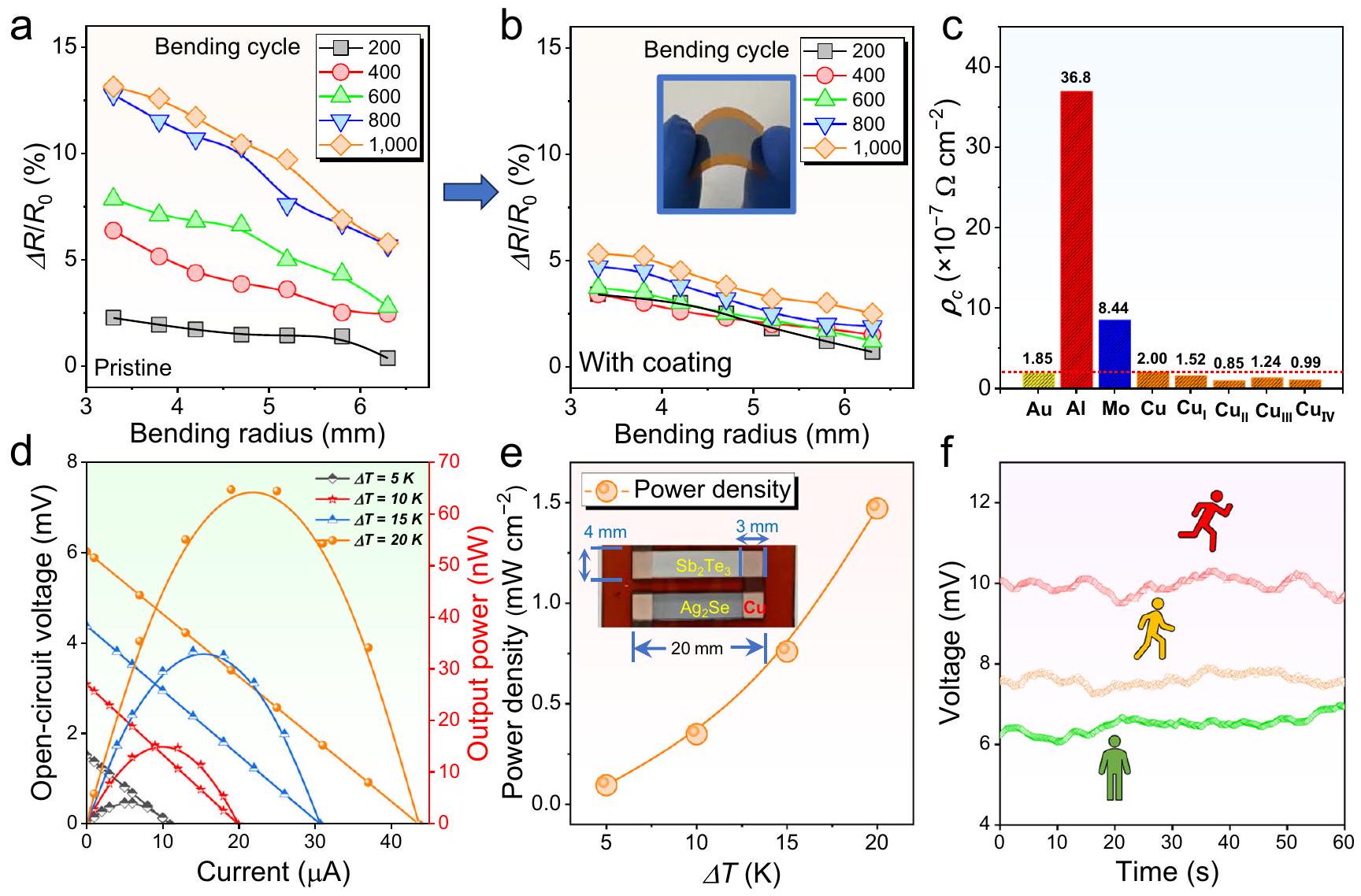
تحميل الحالية عند اختلافات درجات حرارة مختلفة (
تحسين الإمكانيات الكهروحرارية لـ
طرق
تصنيع الأفلام الرقيقة والأجهزة
| المواد | دورة الانحناء |
|
|
مرجع |
|
|
1000 | ٥ | حوالي 20% | 42 |
|
|
٢٠٠٠ | ٧ | حوالي 30% | 43 |
|
|
10 | ٤ و ٦٠ | حوالي 21% | ٤٤ |
|
|
٦٠٠ | ٤ | حوالي 4% | ٤٥ |
|
|
1000 | ٥ | حوالي 20% | ٤٦ |
|
|
100 | 10 | حوالي 6% | ٤٧ |
|
|
1000 | 10 | حوالي 2.5% | ٤٨ |
| المخلوط بالفضة
|
٢٠٠٠ | <6 | <4% | ٦ |
| مُشبع بالتيتانيوم
|
1000 | ~6.3 | حوالي 2.5% | هذا العمل |
توصيفات وتقييم أداء المواد الكهروحرارية
الحساب النظري
| المواد | نوع |
|
|
|
|
||||||||
|
|
|
-146.0 | 990.0 | 21.1 | ||||||||
|
|
|
|
143.2 | ٥١٣.٦ | 10.5 |
توفر البيانات
References
- Liu, R., Wang, Z. L., Fukuda, K. & Someya, T. Flexible self-charging power sources. Nat. Rev. Mater. 7, 870-886 (2022).
- Zhang, L., Shi, X.-L., Yang, Y.-L. & Chen, Z.-G. Flexible thermoelectric materials and devices: From materials to applications. Mater. Today 46, 62-108 (2021).
- Yang, Q. et al. Flexible thermoelectrics based on ductile semiconductors. Science 377, 854-858 (2022).
- Xiao, Y. & Zhao, L.-D. Seeking new, highly effective thermoelectrics. Science 367, 1196 (2020).
- Jiang, B. et al. High-entropy-stabilized chalcogenides with high thermoelectric performance. Science 371, 830-834 (2021).
- Zheng, Z.-H. et al. Harvesting waste heat with flexible
thermoelectric thin film. Nat. Sustain. 6, 180-191 (2023). - Wei, T.-R. et al. Ag2Q-Based (Q = S, Se, Te) silver chalcogenide thermoelectric materials.Adv. Mater 35, 2110236 (2023).
- Zhu, M., Shi, X.-L., Wu, H., Liu, Q. & Chen, Z.-G. Advances in
-based thermoelectrics for wearable electronics: Progress and perspective. Chem. Eng. J. 475, 146194 (2023). - Hou, S. et al. High performance wearable thermoelectric generators using
films with large carrier mobility. Nano Energy 87, 106223 (2021). - Hou, S. et al. High-performance, thin-film thermoelectric generator with self-healing ability for body-heat harvesting. Cell Rep. Phys. Sci. 3, 101146 (2022).
- Xin, C. et al. Solution-processed flexible n-Type S-doped
thermoelectric generators for near-ambient-temperature energy harvest. Mater. Today Energy 33, 101266 (2023). - Lu, Y., Liu, Y., Li, Y. & Cai, K. The influence of Ga doping on preparation and thermoelectric properties of flexible
films. Compos. Commun. 27, 100895 (2021). - Li, Y. et al. Exceptionally high power factor
Polypyrrole composite films for flexible thermoelectric generators. Adv. Funct. Mater. 32, 2106902 (2022). - Lu, Y. et al. Ultrahigh power factor and flexible silver selenide-based composite film for thermoelectric devices. Energy Environ. Sci. 13, 1240-1249 (2020).
- Hu, Q.-X. et al. SWCNTs/
film with superior bending resistance and enhanced thermoelectric performance via in situ compositing. Chem. Eng. J. 457, 141024 (2023). - Jiang, C. et al. Ultrahigh performance polyvinylpyrrolidone/
composite thermoelectric film for flexible energy harvesting. Nano Energy 80, 105488 (2021). - Lu, Y. et al. Ultrahigh performance PEDOT/
composite film for wearable thermoelectric power generators. Mater. Today Phys. 14, 100223 (2020). - Park, D., Ju, H. & Kim, J. Enhanced thermoelectric properties of flexible N-type
nanowire/polyvinylidene fluoride composite films synthesized via solution mixing. J. Ind. Eng. Chem. 93, 333-338 (2021). - Lei, Y. et al. Microstructurally tailored thin
films towards commercial flexible thermoelectrics. Adv. Mater. 34, 2104786 (2021). - Zheng, Z.-H. et al. Significantly (OOl)-textured
thin films with excellent thermoelectric performance for flexible power applications. J. Mater. Chem. A 10, 21603-21610 (2022). - Ding, Y. et al. High performance n-Type
film on nylon membrane for flexible thermoelectric power generator. Nat. Commun. 10, 841 (2019). - Jiang, C. et al. Ultrahigh performance of
-Type films for flexible thermoelectric power generators. ACS Appl. Mater. Interfaces 12, 9646-9655 (2020). - Gao, Q. et al. High power factor
composite films for flexible thermoelectric generators. ACS Appl. Mater. Interfaces 13, 14327-14333 (2021). - Wang, Z. et al. High performance
composite films for wearable thermoelectric power generators. Mater. Today Phys. 21, 100553 (2021). - Geng, J. et al. High power factor n-Type
hybrid film for flexible thermoelectric generator. J. Phys. D. Appl. Phys. 54, 434004 (2021). - Mallick, M. M., Franke, L., Rösch, A. G. & Lemmer, U. Shape-versatile 3D thermoelectric generators by additive manufacturing. ACS Energy Lett. 6, 85-91 (2021).
- Mallick, M. M. et al. High-performance Ag-Se-Based n-Type printed thermoelectric materials for high power density folded generators. ACS Appl. Mater. Interfaces 12, 19655-19663 (2020).
- Perez-Taborda, J. A., Caballero-Calero, O., Vera-Londono, L., Briones, F. & Martin-Gonzalez, M. High thermoelectric zT in n-Type silver selenide films at room temperature. Adv. Energy Mater. 8, 1702024 (2018).
- Jindal, S., Singh, S., Saini, G. S. S. & Tripathi, S. K. Optimization of thermoelectric power factor of (013)-oriented
films via thermal annealing. Mater. Res. Bull. 145, 111525 (2022). - Gao, J. et al. Thermoelectric flexible silver selenide films: compositional and length optimization. iScience 23, 100753 (2020).
- Lu, Y. et al. Staggered-layer-boosted flexible
films with high thermoelectric performance. Nat. Nano 18, 1281-1288 (2023). - Karato, S.-I. An introduction to the rheology of Solid Earth. Vol. 463. 2008: Cambridge University Press Cambridge, UK.
- Mallick, M. M. et al. New frontier in printed thermoelectrics: formation of
Se through thermally stimulated dissociative adsorption leads to high ZT. J. Mater. Chem. A 8, 16366-16375 (2020). - Zheng, Z.-H. et al. Achieving ultrahigh power factor in n -type
thin films by carrier engineering. Mater. Today Energy 24, 100933 (2022). - Li, X. et al. Exceptional power factor of flexible Ag/Ag2Se thermoelectric composite films. Chem. Eng. J. 434, 134739 (2022).
- Almufarij, S. R. et al. Enhanced the thermoelectric power factor of n-type
thin film via energy filtering effect. Inorg. Chem. Commun. 157, 111439 (2023). - Lin, S. et al. Revealing the promising near-room-temperature thermoelectric performance in
single crystals. J. Materiomics 9, 754-761 (2023). - Weathers, A. et al. Significant electronic thermal transport in the conducting polymer Poly(3,4-ethylenedioxythiophene). Adv. Mater. 27, 2101-2106 (2015).
- Li, D. et al. Ce-filled
skutterudite thin films with record-high figure of merit and device performance. Adv. Energy Mater. 13, 2301525 (2023). - Zhu, J. et al. Restructured single parabolic band model for quick analysis in thermoelectricity. NPJ Comput. Mater. 7, 116 (2021).
- Jabar, B. et al. Enhanced power factor and thermoelectric performance for n-type
based composites incorporated with 3D topological insulator nanoinclusions. Nano Energy 80, 105512 (2021). - Shang, H. et al. High-performance Ag-Modified
films for the flexible thermoelectric generator. ACS Appl. Mater. Interfaces 12, 7358-7365 (2020). - Kong, D., Zhu, W., Guo, Z. & Deng, Y. High-performance flexible
films based wearable thermoelectric generator for energy harvesting. Energy 175, 292-299 (2019). - Cao, Z., Tudor, M. J., Torah, R. N. & Beeby, S. P. Screen printable flexible BiTe-SbTe-based composite thermoelectric materials on textiles for wearable applications. IEEE T. Electron Dev. 63, 4024-4030 (2016).
- Li, Y. et al. A flexible and infrared-transparent
-carbon nanotube thermoelectric hybrid for both active and passive cooling. ACS Appl. Electron. Mater. 2, 3008-3016 (2020). - Shang, H. et al.
-based films for flexible thermoelectric devices. J. Mater. Chem. A 8, 4552-4561 (2020). - Jin, Q. et al. Cellulose fiber-based hierarchical porous bismuth telluride for high-performance flexible and tailorable thermoelectrics. ACS Appl. Mater. Interfaces 10, 1743-1751 (2018).
- Varghese, T. et al. Flexible thermoelectric devices of ultrahigh power factor by scalable printing and interface engineering. Adv. Funct. Mater. 30, 1905796 (2020).
- Cao, T., Shi, X.-L. & Chen, Z.-G. Advances in the design and assembly of flexible thermoelectric device. Prog. Mater. Sci. 131, 101003 (2023).
شكر وتقدير
مساهمات المؤلفين
وقاموا بالتعليق على المخطوطة. جميع المؤلفين قد وافقوا على النسخة النهائية من المخطوطة.
المصالح المتنافسة
معلومات إضافية
المواد التكميلية متاحة على
https://doi.org/10.1038/s41467-024-45092-7.
يجب توجيه المراسلات والطلبات للحصول على المواد إلى زوانغهاو تشنغ أو زهي-غانغ تشين.
http://www.nature.com/reprints
© المؤلف(ون) 2024
مختبر شنتشن الرئيسي للأفلام الرقيقة المتقدمة وتطبيقاتها، المختبر الرئيسي للأجهزة البصرية الإلكترونية والأنظمة التابعة لوزارة التعليم ومقاطعة قوانغدونغ، كلية الفيزياء والهندسة البصرية الإلكترونية، جامعة شنتشن، شنتشن، قوانغدونغ 518060، الصين. جامعة رين، CNRS، ISCR (معهد العلوم الكيميائية في رين) UMR 6226، رين F-35000، فرنسا. مدرسة الكيمياء والفيزياء، مركز أبحاث ARC في توليد الطاقة بدون انبعاثات لتحقيق الحياد الكربوني، ومركز علوم المواد، جامعة كوينزلاند للتكنولوجيا، بريسبان، كوينزلاند 4001، أستراليا. معهد أستراليا للهندسة الحيوية والتكنولوجيا النانوية، جامعة كوينزلاند، بريسبان، كوينزلاند 4072، أستراليا. ساهم هؤلاء المؤلفون بالتساوي: دونغ يانغ، شياو-لي شي. البريد الإلكتروني:zhengzh@szu.edu.cn; zhigang.chen@qut.edu.au
DOI: https://doi.org/10.1038/s41467-024-45092-7
PMID: https://pubmed.ncbi.nlm.nih.gov/38296942
Publication Date: 2024-01-31
Flexible power generators by
Accepted: 15 January 2024
Published online: 31 January 2024
(A) Check for updates
Abstract
Exploring new near-room-temperature thermoelectric materials is significant for replacing current high-cost
powered technology
enhance thermoelectric performance. Nevertheless, it is undeniable that optimizing
Results and discussion

and Te can volatilize from the surface during the heat treatment process. Consequently, the final actual compositions differ somewhat from the nominal compositions. Fortunately, the actual Te contents in the films were also increased with increasing the nominal compositions of Te contents. This suggests that Te-doping can be successfully
achieved, and no doping limit has been observed thus far. This indicates that under low-concentration Te-doping conditions, Te-doping has a high success rate. To better analyze the impact of Te doping on the thermoelectric performance of the films, we used the actual atomic concentration of Te as a variable, denoted as
| Nominal composition | Ag (at%) | Se (at%) | Te (at%) |
|
|
66.8 | 33.2 | 0 |
|
|
66.4 | 32.9 | 0.7 |
|
|
66.0 | 32.7 | 1.3 |
|
|
65.6 | 32.5 | 1.9 |
|
|
65.2 | 32.2 | 2.6 |
|
|
64.7 | 32.1 | 3.2 |
|
|
64.3 | 31.9 | 3.8 |

doping exhibits a typical highly orientated feature with isotropic grains since only ( 00 l) peaks (( 002 ) and ( 004 ) peaks) were observed. Figure 2b compares determined orientation factors
showing the contrast difference. The arrow indicates a potential point defect of

transform (FFT) pattern with indexed information.
gradually optimized by increasing the Te doping concentration to achieve peak

obtained high-performance thin film, significant improvements in its flexibility are required. In this work, we designed a protective layer made of organic polymer composites (

measured
results are provided in Supplementary Table 3. Figure 6f compares the measured voltage of wearing the F-TED with five p-n legs for sitting, walking, and running as a function of time. The maximum voltage was obtained when wearing the device while running. This is because during running, there is better heat dissipation at the side of the device that is exposed to the air, which helps maintain a larger temperature gradient and thus allows the device to perform better.

loading current at different temperature differences (
improve the thermoelectric potential of
Methods
Thin film and device fabrication
| Materials | Bending cycle |
|
|
Ref. |
|
|
1000 | 5 | ~20% | 42 |
|
|
2000 | 7 | ~30% | 43 |
|
|
10 | 4 and 60 | ~21% | 44 |
|
|
600 | 4 | ~4% | 45 |
|
|
1000 | 5 | ~20% | 46 |
|
|
100 | 10 | ~6% | 47 |
|
|
1000 | 10 | ~2.5% | 48 |
| Ag -doped
|
2000 | <6 | <4% | 6 |
| Te-doped
|
1000 | ~6.3 | ~2.5% | This Work |
Characterizations and thermoelectric performance evaluation
Theoretical calculation
| Materials | Type |
|
|
|
|
||||||||
|
|
|
-146.0 | 990.0 | 21.1 | ||||||||
|
|
|
|
143.2 | 513.6 | 10.5 |
Data availability
References
- Liu, R., Wang, Z. L., Fukuda, K. & Someya, T. Flexible self-charging power sources. Nat. Rev. Mater. 7, 870-886 (2022).
- Zhang, L., Shi, X.-L., Yang, Y.-L. & Chen, Z.-G. Flexible thermoelectric materials and devices: From materials to applications. Mater. Today 46, 62-108 (2021).
- Yang, Q. et al. Flexible thermoelectrics based on ductile semiconductors. Science 377, 854-858 (2022).
- Xiao, Y. & Zhao, L.-D. Seeking new, highly effective thermoelectrics. Science 367, 1196 (2020).
- Jiang, B. et al. High-entropy-stabilized chalcogenides with high thermoelectric performance. Science 371, 830-834 (2021).
- Zheng, Z.-H. et al. Harvesting waste heat with flexible
thermoelectric thin film. Nat. Sustain. 6, 180-191 (2023). - Wei, T.-R. et al. Ag2Q-Based (Q = S, Se, Te) silver chalcogenide thermoelectric materials.Adv. Mater 35, 2110236 (2023).
- Zhu, M., Shi, X.-L., Wu, H., Liu, Q. & Chen, Z.-G. Advances in
-based thermoelectrics for wearable electronics: Progress and perspective. Chem. Eng. J. 475, 146194 (2023). - Hou, S. et al. High performance wearable thermoelectric generators using
films with large carrier mobility. Nano Energy 87, 106223 (2021). - Hou, S. et al. High-performance, thin-film thermoelectric generator with self-healing ability for body-heat harvesting. Cell Rep. Phys. Sci. 3, 101146 (2022).
- Xin, C. et al. Solution-processed flexible n-Type S-doped
thermoelectric generators for near-ambient-temperature energy harvest. Mater. Today Energy 33, 101266 (2023). - Lu, Y., Liu, Y., Li, Y. & Cai, K. The influence of Ga doping on preparation and thermoelectric properties of flexible
films. Compos. Commun. 27, 100895 (2021). - Li, Y. et al. Exceptionally high power factor
Polypyrrole composite films for flexible thermoelectric generators. Adv. Funct. Mater. 32, 2106902 (2022). - Lu, Y. et al. Ultrahigh power factor and flexible silver selenide-based composite film for thermoelectric devices. Energy Environ. Sci. 13, 1240-1249 (2020).
- Hu, Q.-X. et al. SWCNTs/
film with superior bending resistance and enhanced thermoelectric performance via in situ compositing. Chem. Eng. J. 457, 141024 (2023). - Jiang, C. et al. Ultrahigh performance polyvinylpyrrolidone/
composite thermoelectric film for flexible energy harvesting. Nano Energy 80, 105488 (2021). - Lu, Y. et al. Ultrahigh performance PEDOT/
composite film for wearable thermoelectric power generators. Mater. Today Phys. 14, 100223 (2020). - Park, D., Ju, H. & Kim, J. Enhanced thermoelectric properties of flexible N-type
nanowire/polyvinylidene fluoride composite films synthesized via solution mixing. J. Ind. Eng. Chem. 93, 333-338 (2021). - Lei, Y. et al. Microstructurally tailored thin
films towards commercial flexible thermoelectrics. Adv. Mater. 34, 2104786 (2021). - Zheng, Z.-H. et al. Significantly (OOl)-textured
thin films with excellent thermoelectric performance for flexible power applications. J. Mater. Chem. A 10, 21603-21610 (2022). - Ding, Y. et al. High performance n-Type
film on nylon membrane for flexible thermoelectric power generator. Nat. Commun. 10, 841 (2019). - Jiang, C. et al. Ultrahigh performance of
-Type films for flexible thermoelectric power generators. ACS Appl. Mater. Interfaces 12, 9646-9655 (2020). - Gao, Q. et al. High power factor
composite films for flexible thermoelectric generators. ACS Appl. Mater. Interfaces 13, 14327-14333 (2021). - Wang, Z. et al. High performance
composite films for wearable thermoelectric power generators. Mater. Today Phys. 21, 100553 (2021). - Geng, J. et al. High power factor n-Type
hybrid film for flexible thermoelectric generator. J. Phys. D. Appl. Phys. 54, 434004 (2021). - Mallick, M. M., Franke, L., Rösch, A. G. & Lemmer, U. Shape-versatile 3D thermoelectric generators by additive manufacturing. ACS Energy Lett. 6, 85-91 (2021).
- Mallick, M. M. et al. High-performance Ag-Se-Based n-Type printed thermoelectric materials for high power density folded generators. ACS Appl. Mater. Interfaces 12, 19655-19663 (2020).
- Perez-Taborda, J. A., Caballero-Calero, O., Vera-Londono, L., Briones, F. & Martin-Gonzalez, M. High thermoelectric zT in n-Type silver selenide films at room temperature. Adv. Energy Mater. 8, 1702024 (2018).
- Jindal, S., Singh, S., Saini, G. S. S. & Tripathi, S. K. Optimization of thermoelectric power factor of (013)-oriented
films via thermal annealing. Mater. Res. Bull. 145, 111525 (2022). - Gao, J. et al. Thermoelectric flexible silver selenide films: compositional and length optimization. iScience 23, 100753 (2020).
- Lu, Y. et al. Staggered-layer-boosted flexible
films with high thermoelectric performance. Nat. Nano 18, 1281-1288 (2023). - Karato, S.-I. An introduction to the rheology of Solid Earth. Vol. 463. 2008: Cambridge University Press Cambridge, UK.
- Mallick, M. M. et al. New frontier in printed thermoelectrics: formation of
Se through thermally stimulated dissociative adsorption leads to high ZT. J. Mater. Chem. A 8, 16366-16375 (2020). - Zheng, Z.-H. et al. Achieving ultrahigh power factor in n -type
thin films by carrier engineering. Mater. Today Energy 24, 100933 (2022). - Li, X. et al. Exceptional power factor of flexible Ag/Ag2Se thermoelectric composite films. Chem. Eng. J. 434, 134739 (2022).
- Almufarij, S. R. et al. Enhanced the thermoelectric power factor of n-type
thin film via energy filtering effect. Inorg. Chem. Commun. 157, 111439 (2023). - Lin, S. et al. Revealing the promising near-room-temperature thermoelectric performance in
single crystals. J. Materiomics 9, 754-761 (2023). - Weathers, A. et al. Significant electronic thermal transport in the conducting polymer Poly(3,4-ethylenedioxythiophene). Adv. Mater. 27, 2101-2106 (2015).
- Li, D. et al. Ce-filled
skutterudite thin films with record-high figure of merit and device performance. Adv. Energy Mater. 13, 2301525 (2023). - Zhu, J. et al. Restructured single parabolic band model for quick analysis in thermoelectricity. NPJ Comput. Mater. 7, 116 (2021).
- Jabar, B. et al. Enhanced power factor and thermoelectric performance for n-type
based composites incorporated with 3D topological insulator nanoinclusions. Nano Energy 80, 105512 (2021). - Shang, H. et al. High-performance Ag-Modified
films for the flexible thermoelectric generator. ACS Appl. Mater. Interfaces 12, 7358-7365 (2020). - Kong, D., Zhu, W., Guo, Z. & Deng, Y. High-performance flexible
films based wearable thermoelectric generator for energy harvesting. Energy 175, 292-299 (2019). - Cao, Z., Tudor, M. J., Torah, R. N. & Beeby, S. P. Screen printable flexible BiTe-SbTe-based composite thermoelectric materials on textiles for wearable applications. IEEE T. Electron Dev. 63, 4024-4030 (2016).
- Li, Y. et al. A flexible and infrared-transparent
-carbon nanotube thermoelectric hybrid for both active and passive cooling. ACS Appl. Electron. Mater. 2, 3008-3016 (2020). - Shang, H. et al.
-based films for flexible thermoelectric devices. J. Mater. Chem. A 8, 4552-4561 (2020). - Jin, Q. et al. Cellulose fiber-based hierarchical porous bismuth telluride for high-performance flexible and tailorable thermoelectrics. ACS Appl. Mater. Interfaces 10, 1743-1751 (2018).
- Varghese, T. et al. Flexible thermoelectric devices of ultrahigh power factor by scalable printing and interface engineering. Adv. Funct. Mater. 30, 1905796 (2020).
- Cao, T., Shi, X.-L. & Chen, Z.-G. Advances in the design and assembly of flexible thermoelectric device. Prog. Mater. Sci. 131, 101003 (2023).
Acknowledgements
Author contributions
and commented on the manuscript. All authors have given approval to the final version of the manuscript.
Competing interests
Additional information
supplementary material available at
https://doi.org/10.1038/s41467-024-45092-7.
Correspondence and requests for materials should be addressed to Zhuanghao Zheng or Zhi-Gang Chen.
http://www.nature.com/reprints
© The Author(s) 2024
Shenzhen Key Laboratory of Advanced Thin Films and Applications, Key Laboratory of Optoelectronic Devices and Systems of Ministry of Education and Guangdong Province, College of Physics and Optoelectronic Engineering, Shenzhen University, Shenzhen, Guangdong 518060, China. Univ Rennes, CNRS, ISCR (Istitut des Sciences Chimiques de Rennes) UMR 6226, Rennes F-35000, France. School of Chemistry and Physics, ARC Research Hub in Zero-emission Power Generation for Carbon Neutrality, and Centre for Materials Science, Queensland University of Technology, Brisbane, QLD 4001, Australia. Australian Institute for Bioengineering and Nanotechnology, The University of Queensland, Brisbane, QLD 4072, Australia. These authors contributed equally: Dong Yang, Xiao-Lei Shi. e-mail: zhengzh@szu.edu.cn; zhigang.chen@qut.edu.au
